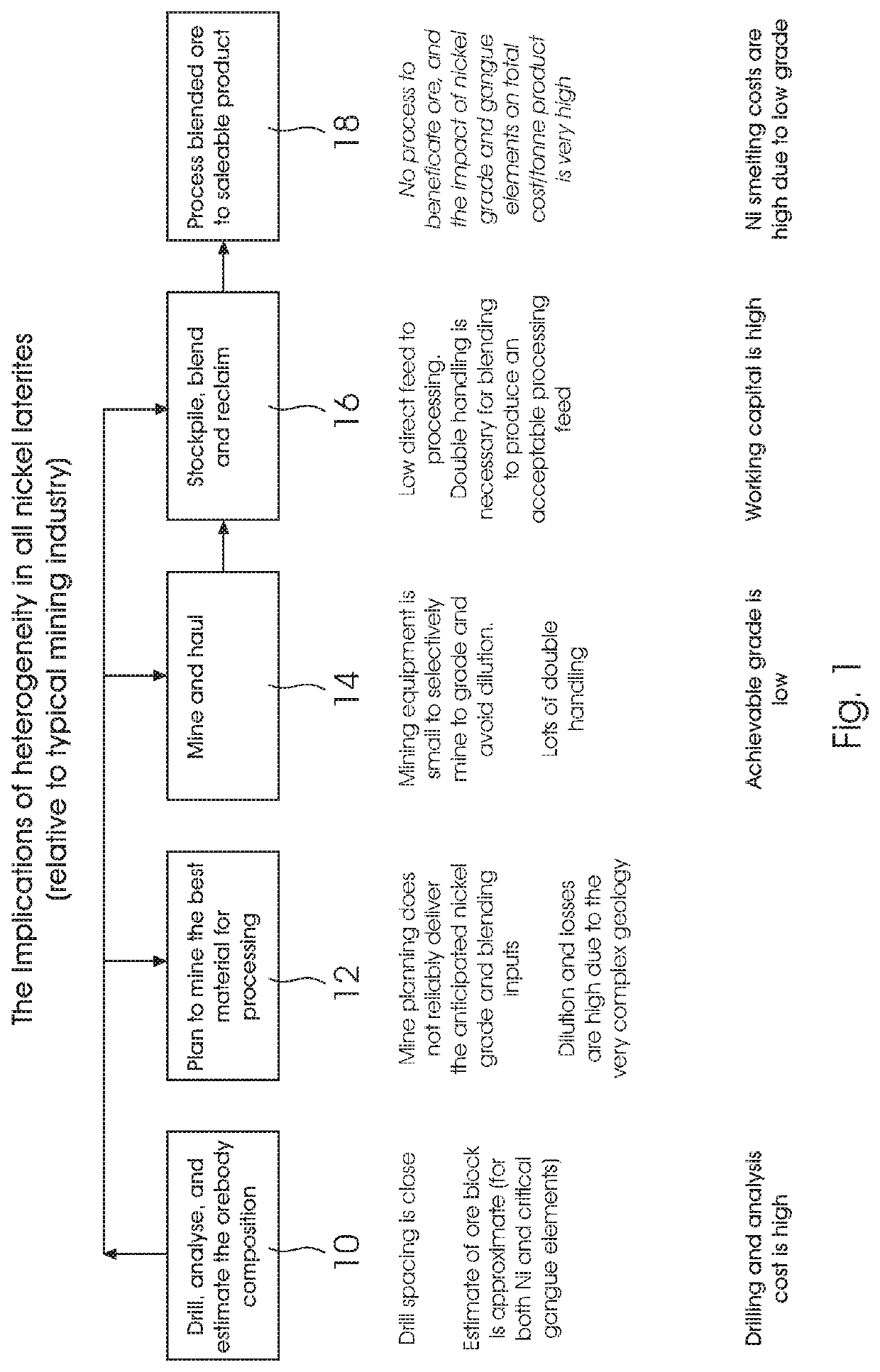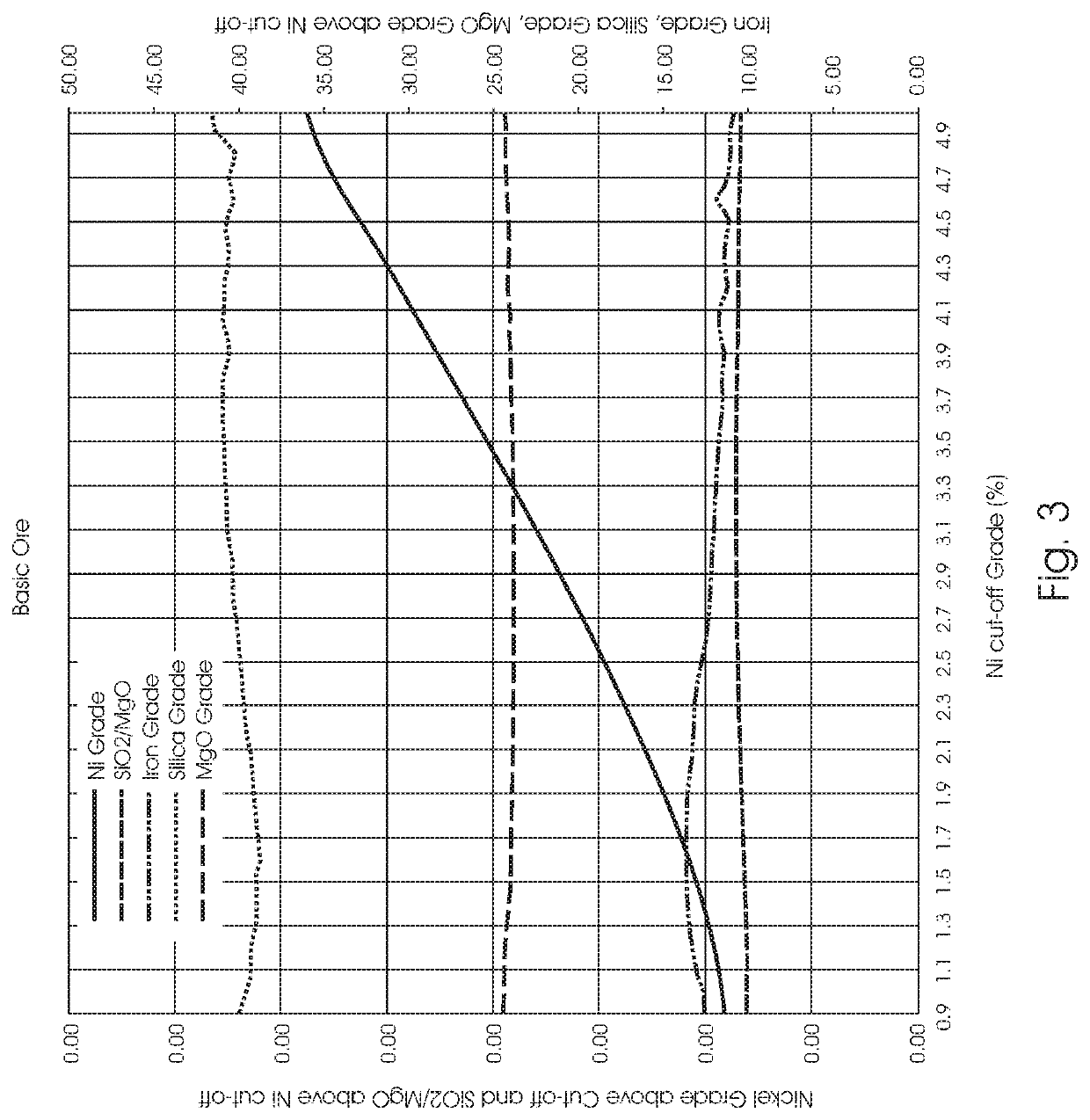The
limonite fraction of ore is typically too low in nickel grade to be smelted economically, and hence represents ‘waste’ in the smelter feed.
The limonite also contains cobalt and sometimes
copper, which can cause problems when the ferronickel is used for stainless steel production.
In addition to the importance of nickel grade on the viability of processing an ore, the
gangue content can also prove problematic.
Due to the large proportion of
gangue in the ore (typically over 98%), energy,
consumables, and transport costs of processing the ore are high.
This
beneficiation constraint restricts the use of the reasonably abundant nickel laterite resources, to those that are sufficiently high grade and long life to justify the major
capital investment in the processing equipment and infrastructure.
Many known laterite resources remain undeveloped, because their nickel grade or size cannot justify the high cost of processing.
For these reasons, beneficiating the
nickel content of the lateritic ore has long been a desire of the metallurgical world, but no broadly applicable technique has been found.
The screening process is not applicable to all ore types, and is also very difficult to operate with sticky ore which is mined in the
wet season.
Nor can the nickel laterites be selectively mined to recover only the high-grade areas, at a scale which is consistent with the requirements of a commercial operation.
This heterogeneity is typically non-uniform across the orebody in any dimension, including both the location of the limonite / saprolite / waste rock stratification, and also within each of the nickel laterite
layers.
In a heterogeneous ore like nickel laterite, this method of
estimation is more prone to error in nickel,
impurity and
gangue compositions, than in a more consistent orebody.
Whilst the optimum
drill spacing used for grade control drilling of nickel laterites is around 10-15 m, and closer than typical in the base
metals industry, it is still much too widely spaced to selectively identify the higher-grade patches of a laterite ore.
And even if grade control drilling were very closely spaced, and techniques such as high precision global positioning systems were used to spatially control the coordinates for ore loading, the variability in the vertical dimension of the orebody would prevent any practical form of selective mining.
Thus, mining of the different zones must be followed by blending, and selective mining to meet gangue specifications is again not possible, except in limited circumstances.
At the drilling stage 10,
drill spacing is close, and drilling and analyse cost is high.
The planning 12 does not reliably deliver anticipated nickel
upgrade and blended inputs, and
dilution and losses high due to the very complex geology.
At the processing and blending 18, there is no process to beneficiate ore, and
impact of nickel grade and gangue elements and total cost /
ton product is very high.
The activities after the grade
estimation are necessarily imprecise due to the orebody heterogeneity between the grade control holes.
The consequences of the uncertainty around ore
estimation is the large number of stockpiles.
The cost of the small-scale mining equipment to improve mining precision, and the double handling of the ore to achieve the blending and to leave ore for processing late in the mine life, is significant.
Another unusual characteristic of the processing of nickel laterites, is the
relative cost of mining and processing.
Unlike most base metals, the cost of processing laterites is significantly higher than the cost of mining the ore.
For all these reasons, the use of nickel laterites has been limited to relatively few large high-grade orebodies, and
technology development efforts have been focussed on finding lower cost processes for smelting or leaching of the ores as the naturally exist.
The potential application of bulk sorting to nickel laterites, has been considered, but is potentially problematic.
Beyond this, the Bamber provides no guidance on how the sorting equipment could be integrated into the activities required for nickel laterite mining, blending and processing.
For
recovery of most metals, the mining cost per tonne is high, relative to subsequent processing costs.
The high processing costs per tonne for nickel laterites, relative to their mining cost, makes the potential application of bulk sorting quite different.
 Login to View More
Login to View More 


